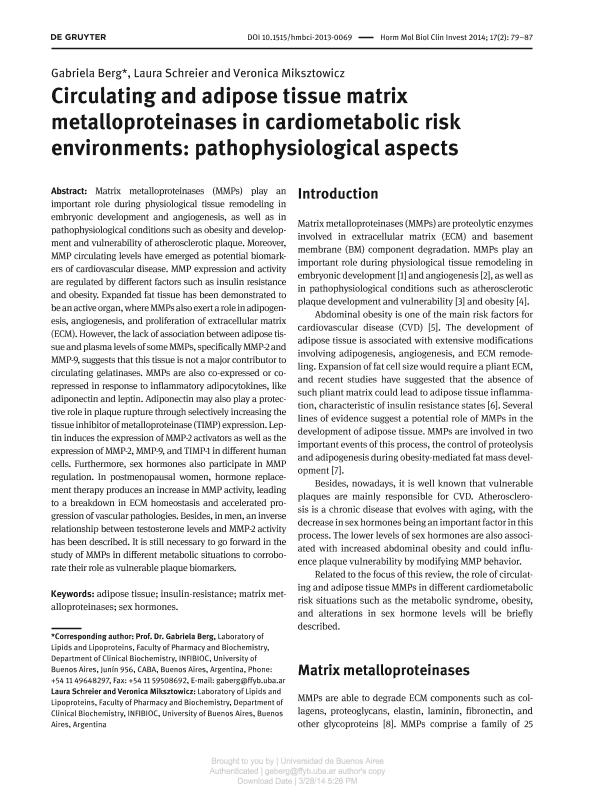Mostrar el registro sencillo del ítem
dc.contributor.author
Berg, Gabriela Alicia

dc.contributor.author
Schreier, Laura Ester
dc.contributor.author
Miksztowicz, Veronica Julieta

dc.date.available
2017-05-18T20:20:54Z
dc.date.issued
2014-02
dc.identifier.citation
Berg, Gabriela Alicia; Schreier, Laura Ester; Miksztowicz, Veronica Julieta; Circulating and adipose tissue matrix metalloproteinases in cardiometabolic risk environments: pathophysiological aspects; De Gruyter; Hormone Molecular Biology and Clinical Investigation; 17; 2; 2-2014; 79-87
dc.identifier.issn
1868-1883
dc.identifier.uri
http://hdl.handle.net/11336/16681
dc.description.abstract
Matrix metalloproteinases (MMPs) play an important role during physiological tissue remodeling in embryonic development and angiogenesis, as well as in pathophysiological conditions such as obesity and development and vulnerability of atherosclerotic plaque. Moreover, MMP circulating levels have emerged as potential biomarkers of cardiovascular disease. MMP expression and activity are regulated by different factors such as insulin resistance and obesity. Expanded fat tissue has been demonstrated to be an active organ, where MMPs also exert a role in adipogenesis, angiogenesis, and proliferation of extracellular matrix (ECM). However, the lack of association between adipose tissue and plasma levels of some MMPs, specifically MMP-2 and MMP-9, suggests that this tissue is not a major contributor to circulating gelatinases. MMPs are also co-expressed or co-repressed in response to inflammatory adipocytokines, like adiponectin and leptin. Adiponectin may also play a protective role in plaque rupture through selectively increasing the tissue inhibitor of metalloproteinase (TIMP) expression. Leptin induces the expression of MMP-2 activators as well as the expression of MMP-2, MMP-9, and TIMP-1 in different human cells. Furthermore, sex hormones also participate in MMP regulation. In postmenopausal women, hormone replacement therapy produces an increase in MMP activity, leading to a breakdown in ECM homeostasis and accelerated progression of vascular pathologies. Besides, in men, an inverse relationship between testosterone levels and MMP-2 activity has been described. It is still necessary to go forward in the study of MMPs in different metabolic situations to corroborate their role as vulnerable plaque biomarkers.
dc.format
application/pdf
dc.language.iso
eng
dc.publisher
De Gruyter

dc.rights
info:eu-repo/semantics/openAccess
dc.rights.uri
https://creativecommons.org/licenses/by-nc-sa/2.5/ar/
dc.subject
Adipose Tissue
dc.subject
Insulin Resistance
dc.subject
Matrix Metalloproteinases
dc.subject
Sex Hormones
dc.subject.classification
Otras Ciencias de la Salud

dc.subject.classification
Ciencias de la Salud

dc.subject.classification
CIENCIAS MÉDICAS Y DE LA SALUD

dc.title
Circulating and adipose tissue matrix metalloproteinases in cardiometabolic risk environments: pathophysiological aspects
dc.type
info:eu-repo/semantics/article
dc.type
info:ar-repo/semantics/artículo
dc.type
info:eu-repo/semantics/publishedVersion
dc.date.updated
2017-05-15T14:45:03Z
dc.identifier.eissn
1868-1891
dc.journal.volume
17
dc.journal.number
2
dc.journal.pagination
79-87
dc.journal.pais
Alemania

dc.journal.ciudad
Berlín
dc.description.fil
Fil: Berg, Gabriela Alicia. Universidad de Buenos Aires. Facultad de Farmacia y Bioquímica. Departamento de Bioquímica Clínica; Argentina. Consejo Nacional de Investigaciones Científicas y Técnicas; Argentina
dc.description.fil
Fil: Schreier, Laura Ester. Universidad de Buenos Aires. Facultad de Farmacia y Bioquímica. Departamento de Bioquímica Clínica; Argentina. Consejo Nacional de Investigaciones Científicas y Técnicas; Argentina
dc.description.fil
Fil: Miksztowicz, Veronica Julieta. Universidad de Buenos Aires. Facultad de Farmacia y Bioquímica. Departamento de Bioquímica Clínica; Argentina. Consejo Nacional de Investigaciones Científicas y Técnicas; Argentina
dc.journal.title
Hormone Molecular Biology and Clinical Investigation
dc.relation.alternativeid
info:eu-repo/semantics/altIdentifier/url/https://www.degruyter.com/view/j/hmbci.2014.17.issue-2/hmbci-2013-0069/hmbci-2013-0069.xml
dc.relation.alternativeid
info:eu-repo/semantics/altIdentifier/doi/http://dx.doi.org/10.1515/hmbci-2013-0069
Archivos asociados
